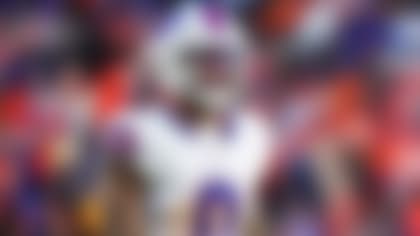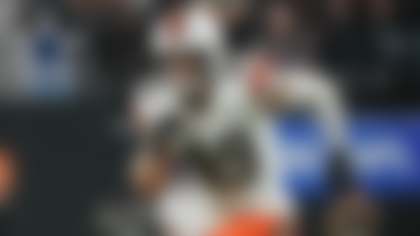INDIANAPOLIS -- By the time the NFL's 32 teams arrive here for next week's NFL Scouting Combine, much of the work that goes into the draft will be done.
Debate: Can't-miss prospects
Besides Andrew Luck, who is the most can't-miss prospect at any position in the 2012 NFL Draft. Our analysts debate. **More ...**
Every player invited to the combine has put a college career on tape, area scouts have made dozens of campus visits, draft meetings have been held, initial boards have been set and opinions have formed.
Can things change between now and April 26? Certainly. But the most important stuff -- the track record that counts -- is already in the books.
With that in mind, here are five of the most intriguing questions -- that still need to be answered -- going into next week's Indianapolis meat market ...
How big is Robert Griffin?
Since they do indeed have tape measures and scales in Waco, this may seem like a silly question to ask about the Baylor quarterback. But taking someone at that position at the juncture of the draft where Griffin's expected to go -- second overall -- is a mighty big decision for a franchise. And most of the decision-makers for franchises considering him will get their first chance to eyeball him in Indy.
Smith: Your team's QB or RG3?
Can Robert Griffin III take the Jets to the Super Bowl? Jason Smith suggests Gang Green should be one of the teams to move their QB for RG3. **More ...**
"Is he 6-1 or 6-2? Is he 200 pounds or 220?" an AFC college scout said. "One of the biggest questions with him concerns his style of play vs. his body's ability to make it through 16 weeks. So you have to ask the question with the thing that makes him special, that off-the-charts athleticism. Is he going to be able to use that, and survive the grind in the pros? Remember, Sam Bradford had some of these questions, too, and he weighed in well above what people thought he would, and it really helped him."
With Griffin, it's the difference between Mike Vick, who sometimes struggles to stay on the field, and Ben Roethlisberger or Cam Newton, who are built to withstand the pounding. And of course, the interview process for Griffin will be important, too, and not just because he'll have to explain how he plans to transition from Baylor's spread offense.
"With a quarterback, you have to feel like you can see him in your uniform, playing under your coach, running your coordinator's offense," an AFC personnel director said. "That's a vital meeting with the coach and GM. When you're meeting with a defensive end or a tackle, you don't look at the player as a potential centerpiece. So the interview process is huge for Griffin. The workout is secondary."
Is Ryan Tannehill a winner?
Last year provides a perfect example of how quarterbacks get pushed up the board -- four went in the first dozen picks, despite the fact that the crop was seen as just so-so by folks around the league. This time around, we know Andrew Luck is a near-lock to go first. RG3's a good bet to go second. And Texas A&M's Ryan Tannehill is next in the pecking order, a candidate for the kind of meteoric rise that Christian Ponder had in 2010. One black mark he'll fight this week: a 7-6 record last year.
"What he needs to answer: Why couldn't you win a game?" a college scout said. "He's got all the throwing talent, the athletic ability, the strength. You can see everything, it's all there. But when it's nut-cutting time, you don't see it. A&M had a lot of close games, and something would always go wrong."
Tannehill's also rehabbing a broken foot, and the fact that he won't work out here will only amplify the interview, since he won't get back on the field until well into next month. One thing that will help is the good words of others, with Dolphins offensive coordinator Mike Sherman, his coach at A&M, having vouched for him in the past to clubs. "From that standpoint, I wouldn't consider Tannehill an 'edge' guy," an NFC personnel executive said, "because he's so highly recommended by the A&M group."
Because of his athleticism, Tannehill could wind up in the top 10, perhaps fitting a team like the Redskins. A little high? Well, some clubs have him as a better prospect now than they had Blaine Gabbert or Ponder last year, so it's not as far-fetched as it might seem.
How will the offensive line shake out?
We know that USC tackle Matt Kalil will be off the board quickly, even if he's not perfect. "You gotta look at body type with him," one AFC personnel executive said, "and growth potential, because he's not a power player."
After that, things get cloudier, with the idea being that there are a lot of good players available, but no real great ones. An average of 6.4 offensive linemen have gone in the first round over the last five years, and it's one of the most stable positions draft-to-draft in that regard. The question is whether guys like Stanford's Jonathan Martin and Iowa's Riley Reiff are closer to the top or bottom of the first round.
"I don't think there's a second or third tackle where you say, 'I gotta have this guy in the first round,' " the AFC personnel director said. "Martin might be comparable to someone you see in the second round, and there are differing opinions on the guards, particularly [Stanford's David] DeCastro. The kid from Midwestern State [Amini Silatolu] is more talented, but are you comfortable with a juco guy who wound up there? There are lots of questions like that."
These positions aren't the sexiest ones, but generally there are runs on linemen at spots in the draft, and part of the work in Indy for the evaluators will be figuring where those should happen in the first and second rounds.
Who's the second tailback?
Brooks: RB prospect rankings
Trent Richardson isn't the only talented running back in the 2012 NFL Draft. Bucky Brooks ranks his top five at the position. **More ...**
You can mark this one down: Trent Richardson will be the first back off the board. And after that, it's anyone's guess. Virginia Tech's David Wilson, Miami's Lamar Miller and Oregon's LaMichael James headline the next tier, and one of those guys burning up the 40 -- like Chris Johnson did in 2008 -- could wind up being a tie-breaker.
"They're situational guys," the AFC personnel director said. "There isn't a lot of strength at the position, but I can see a team taking James because he runs well, and saying, 'OK, he's situational, but in our offense, he'll get enough snaps to justify taking him in the first round.' "
So even while the proliferation of the NFL passing game has deemphasized this position in a global sense, there are players with versatility and quick-strike skill, like James, that can wind up benefitting from the evolution of offenses.
Where are the pass-rushers?
The Giants' second Super Bowl triumph in five seasons will shine the spotlight on teams looking for explosive edge-rushers, something New York has by the bucketful. And that spotlight will show a pretty bare shelf when it comes to this draft class.
"It's disappointing," the AFC scout of the class said. "What will happen is you'll have someone with prototype measurables have a good workout there (at the combine), and he'll get taken higher. This is a rough year for pass rushers."
One name to keep an eye on in that regard is Illinois' Whitney Mercilus, an athletic freak who declared for the draft after a breakout junior year and could be the second edge player selected behind Alabama's Courtney Upshaw.
Where are the safeties?
This is a problem that's not specific to this draft. It's one, talking to folks around the league, that's becoming a real problem in general, with bigger safeties being converted to linebacker to combat spread offenses and corners lacking prototypical NFL size being moved safety to fill the void. Scouts and execs say it's increasingly difficult to find a traffic director back there, with defenses simplified to combat spread offenses, as well.
Alabama's Mark Barron stands alone atop the board, because he played in a NFL-style system with NFL-type responsibilities and NFL size. Safety-needy teams that don't get Barron may have to get creative, looking at bigger corners or smaller linebackers to convert to play on the back end of the defense.
Follow Albert Breer on Twitter @AlbertBreer



